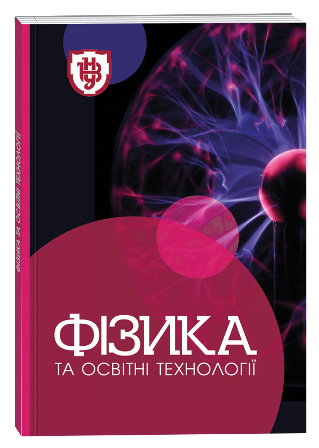THE MAGNETIC FIELD EFFECT ON THE OPTICAL PROPERTIES ОF TYPE II QUANTUM DOTS (AHARONOV – BOHM EFFECT)
DOI:
https://doi.org/10.32782/pet-2023-3-3Keywords:
quantum dots, type II heterojunction, magnetic field, energy spectrum of quasiparticles, oscillator strength of quantum transitions, ground state oscillations, Aharonov –Bohm effectAbstract
Due to the spatial separation of electrons and holes in core/shell semiconductor QDs with a type II heterojunction, new optical properties unavailable in other QDs can be manifested. Therefore, such nanosystems are intensively studied for the possibility of use in new nanodevices. The purpose of this work is to determine the influence of the magnetic field on the energy structure and interband optical quantum transitions in spherical quantum dots of type II ZnTe/CdSe and CdSe/ZnTe. The problem was solved by two methods: the finite element method in the COMSOL Multiphysics system and the diagonalization method in the Wolfram Mathematica system based on exact solutions of the Schrödinger equation in a system undisturbed by a magnetic field. The results obtained by both methods coincide with great accuracy. The last method is more complicated, but it made it possible to determine the partial contribution of the basic states in the new quantum states of quasiparticles obtained as a result of the action of a magnetic field. The dependence of the energy spectra and wave functions of the electron and hole on the magnetic field for spherical quantum dots ZnTe/CdSe and CdSe/ZnTe with different core sizes was obtained in the paper. It is shown that the magnetic field breaks the spherical symmetry of the system and removes the degeneracy of the energy spectrum according to the magnetic quantum number. The energy of quasiparticles in states with m ≥ 0 increases monotonically with increasing magnetic field, and in states with m < 0 these dependences are non-monotonic. The energy of the ground state of the electron in ZnTe/CdSe and the energy of the ground state of the hole in CdSe/ ZnTe with increasing induction of the magnetic field are alternately formed by the lowest states 0, 1, 2, ... . This is a consequence of the Aaronov – Bohm effect in core/shell CT. It is shown that the magnetic field deforms the wave functions of quasiparticles and affects the amount of their overlap. This is manifested in the dependence of the oscillator strength of interband quantum transitions on the induction of the magnetic field. It is shown that the Aaronov – Bohm effect can manifest itself in interband quantum transitions.
References
Nizamoglu S., Demir H. V. Onion-like (CdSe)ZnS/CdSe/ZnS quantum-dot-quantum-well heteronanocrystals for investigation of multi-color emission. Optics Express. 2008. Vol. 16. № 6. P. 3515.
Nizamoglu S., Mutlugun E., Özel T., Demir H. V., Sapra, S., Gaponik N., Eychmüller A. Dual-color emitting quantum-dot-quantum-well CdSe-ZnS heteronanocrystals hybridized on InGaNGaN light emitting diodes for high-quality white light generation. Applied Physics Letters . 2008.Vol. 92. № 11. P. 1–3.
Zhang W., Chen G., Wang J., Ye B. C., Zhong X. Design and synthesis of highly luminescent near-infraredemitting water-soluble CdTe/CdSe/ZnS Core/Shell/Shell quantum dots Type II. Inorganic Chemistry. 2009. Vol. 48. № 20. P. 9723–9731.
Tyagi P., Kambhampati P. Independent control of electron and hole localization in core/barrier/shell nanostructures. Journal of Phys. Chemistry C. 2012. Vol. 116. № 14. P. 8154–8160.
Корбутяк Д.В., Коваленко О.В., Будзуляк С.І., Калитчук С.М., Купчак I. М. Свiтловипромiнюючi властивостi квантових точок напівпровідникових сполук АIIВVI. Український Фiзичний Журнал. 2012. Т. 7. № 1. С. 48–95.
Pidluzhna А., Ivaniuk K., Stakhira P., Hotra Z., Chapran M., Ulanski J., Tynkevych O., Khalavka Y., Baryshnikov G. V., Minaev B. F., Ågren H. Multi-channel electroluminescence of CdTe/CdS core-shell quantum dots implemented into a QLED device. Dyes and Pigments. 2019. Vol. 162. P. 647–653.
Doskaliuk N., Khalavka Y., Fochuk P. Influence of the Shell Thickness and Ratio Between Core Elements on Photostability of the CdTe/CdS Core/Shell Quantum Dots Embedded in a Polymer Matrix. Nanoscale Research Letters. 2016. Vol. 11. № 1. P. 216.
Wang L., Nonaka K., Okuhata T., Katayama T., Tamai N. Quasi-Type II Carrier Distribution in CdSe/CdS Core/Shell Quantum Dots with Type I Band Alignment. Journal of Physical Chemistry C. 2018. Vol. 122. № 22. P. 2038–12046.
AbouElhamd A. R., Al-Sallal K. A., Hassan A. Review of core/shell quantum dots technology integrated into building’s glazing. Energies. 2019. Vol. 12. № 6. P. 1058.
Rahimi F., Ghaffary T., Naimi Y., Khajehazad H. Optical and Quantum Electronics Effect of magnetic field on energy states and optical properties of quantum dots and quantum antidots. Optical and Quantum Electronics. 2021. Vol. 53. № 1. P. 47.
Holovatsky V. A., Frankiv I. B. Oscillator strength of quantum transition in multi-shell quantum dots with impurity. Journal of Optoelectronics and Advanced Materials. 2013. Vol.15. № 1–2. P. 88.
Reiss P., Protière M., Li L. Core/shell semiconductor nanocrystals. Small. 2009. Vol. 5. № 2. P. 154-168.
Klenovský P., Steindl P., Geffroy D. Excitonic structure and pumping power dependent emission blue- shift of type-II quantum dots. Scientific REPORTS. 2017. Vol. 7. № 1. P. 45568.
Naifar A., Zeiri N., Nasrallah S. A. Ben Said, M. Optical properties of CdSe/ZnTe type II core shell nanostructures. Optik. 2017. Vol. 146. P. 90–97.
Saravanamoorthy S. N., John Peter A. Interband Optical Transition Energies in Type-II PbSe/PbS Core/Shell Quantum Dots. Journal of Advanced Physics. 2017. Vol. 6. № 1. P. 80–86.
Jiao S., Shen Q., Mora-Seró I., Wang J., Pan Z., Zhao K., Kuga Y., Zhong X., Bisquert J. Band engineering in core/shell ZnTe/CdSe for photovoltage and efficiency enhancement in exciplex quantum dot sensitized solar cells. ACS Nano. 2015. Vol. 9. № 1. P. 908–915.
Ma X., Mews A., Kipp T. Determination of electronic energy levels in type-II CdTe-core/CdSe-shell and CdSecore/CdTe-shell nanocrystals by cyclic voltammetry and optical spectroscopy. Journal of Physical Chemistry C. 2013. Vol.117. № 32. P. 16698–16708.
Long T., Cao J., Jiang Z. J. Predictable spectroscopic properties of type-II ZnTe/CdSe nanocrystals and electron/hole quenching. Physical Chemistry Chemical Physics. 2019. Vol. 21. № 10. P. 5824–5833.
Verma S., Kaniyankandy S., Ghosh H. N. Charge separation by indirect bandgap transitions in CdS/ZnSe type-II core/shell quantum dots. Journal of Physical Chemistry C. 2013. Vol.117. № 21. P. 10901–10908.
Nandan Y., Mehata M. S. Wavefunction Engineering of Type-I/Type-II Excitons of CdSe/CdS Core-Shell Quantum Dots. Scientific Reports. 2019. Vol. 9. № 1. P. 1–11.
Selopal G. S., Zhao H., Wang Z. M., Rosei F. Core/Shell Quantum Dots Solar Cells. Advanced Functional Materials. 2020. Vol. 30. № 13. P. 1908762.
Koç F., Sahin M. The electronic and optical properties of an exciton, biexciton and charged excitons in CdSe/CdTebased multi-shell type-II quantum dot nanocrystals. Applied Physics A: Materials Science and Processing. 2019. Vol. 125. № 10. P. 1–9.
Tyrrell E. J., Smith J. M. Effective mass modeling of excitons in type-II quantum dot heterostructures. Physical Review B - Condensed Matter and Materials Physics. 2011. Vol. 84. № 16. P. 165328.
Holovatsky V. A., Chubrei M. V, Duque C. A. Core-shell type-II spherical quantum dot under externally applied electric field. Thin Solid Films. 2022. Vol. 747. P. 139142.
Chafai A., Dujardin F., Essaoudi I., Ainane A. Energy spectrum of an exciton in a CdSe/ZnTe type-II core/shell spherical quantum dot. Superlattices and Microstructures. 2017. Vol. 101. P. 40–48.
Chafai A., Essaoudi I., Ainane A., Dujardin F., Ahuja R. ZnTe/CdSe type-II core / shell spherical quantum dot under an external electric field. Materials and Devices. 2018. Vol. 3. № 1. P. 0504.
Nasri D., Bettahar N. Magneto-optical properties in inhomogeneous quantum dot: The Aharonov-Bohm oscillations effect. Physica B: Condensed Matter. 2016. Vol. 501. P. 68–73.
Çakır B., Atav Ü., Yakar Y., Özmen A. Calculation of Zeeman splitting and Zeeman transition energies of spherical quantum dot in uniform magnetic field. Chemical Physics. 2016. Vol. 475. P. 61–68.
Feddi E., Talbi A., Mora-Ramos M. E., El Haouari M., Dujardin F., Duque C. A. Linear and nonlinear magnetooptical properties of an off-center single dopant in a spherical core/shell quantum dot. Physica B: Condensed Matter. 2017. Vol. 524. P. 64.
Holovatsky V., Bernik I., Yakhnevych M. Effect of magnetic field on electron spectrum and probabilities of intraband quantum transitions in spherical quantum-dot-quantum-well. Physica E: Low-Dimensional Systems and Nanostructures. 2016. Vol. 83. P. 256–262.
Holovatsky V. A., Bernik I. B., Yakhnevych M. Y. Effect of magnetic field on energy spectrum and localization of electron in CdS/HgS/CdS/HgS/CdS multilayered spherical nanostructure. Physica B: Condensed Matter. 2017. Vol. 508. P. 112–117.
Holovatsky V. A., Voitsekhivska О. M., Yakhnevych M. Y. The effect of magnetic field and donor impurity on electron spectrum in spherical core-shell quantum dot. Superlattices and Microstructures. 2018. Vol. 116. P. 9–16.
Chubrei M. V., Holovatsky V. A., Duque C. A. Effect of magnetic field on donor impurity-related photoionisation cross-section in multilayered quantum dot. Philosophical Magazine. 2021. Vol. 101. № 24. P. 2614–2633.
Lorke A., Johannes Luyken R., Govorov A. O., Kotthaus J. P., Garcia J. M., Petroff P. M. Spectroscopy of Nanoscopic Semiconductor Rings. Physical Review Letters. 2000. Vol.84. № 10. P. 2223–2226.
Kuskovsky I. L., MacDonald W., Govorov A. O., Mourokh L., Wei X., Tamargo M. C., Tadic M., Peeters F. M. Optical Aharonov-Bohm effect in stacked type-II quantum dots. Physical Review B - Condensed Matter and Materials Physics. 2007. Vol. 76. № 3. P. 1–15.
Kuskovsky I. L., Mourokh L. G., Roy B., Ji, H., Dhomkar S., Ludwig J., Smirnov D., Tamargo M. C. Decoherence in semiconductor nanostructures with type-II band alignment: All-optical measurements using Aharonov-Bohm excitons. Physical Review B. 2017. Vol. 95. № 16. P. 165445.
Sellers I. R., Whiteside V. R., Kuskovsky I. L., Govorov A. O., McCombe B. D. Aharonov-Bohm Excitons at Elevated Temperatures in Type-II Quantum Dots. Physical Review Letters. 2008. Vol. 100. № 13. P. 136405.
Sellers I. R., Whiteside V. R., Kuskovsky I. L., Govorov A. O., Mccombe B. D. Modulation of the Aharonov – Bohm effect in type-II II – V ZnSe : Te quantum dots by a far-infrared laser. Physica E: Low-Dimensional Systems and Nanostructures. 2008. Vol. 40. № 6. P. 1819–1823.
Yao Y., Elborg M., Kuroda T., Sakoda K. Excitonic Aharonov–Bohm effect in QD-on-ring nanostructures. Journal of Physics: Condensed Matter. 2017. Vol. 29. № 38. P. 385301.
Sahin M., Nizamoglu S., Kavruk A. E., Demir H. V. Self-consistent computation of electronic and optical properties of a single exciton in a spherical quantum dot via matrix diagonalization method. Journal of Applied Physics. 2009. Vol. 106. № 4. P. 5.
Cheche T. O., Barna V., Chang Y. C. Analytical approach for type-II semiconductor spherical core-shell quantum dots heterostructures with wide band gaps. Superlattices and Microstructures. (2013). Vol. 60. P. 475–486.
Wu S. Cheng L. Exciton diamagnetic shift and optical properties in CdSe nanocrystal quantum dots in magnetic fields. Physica B: Condensed Matter. 2018. Vol. 534. P. 98.
Gambaryan K. M., Aroutiounian V. M., Harutyunyan V. G. and Yeranyan L. S. Preface: International Conference on Recent Trends in Physics (ICRTP 2016). Journal of Physics: Conference Series. 2017. Vol. 829. 1.








